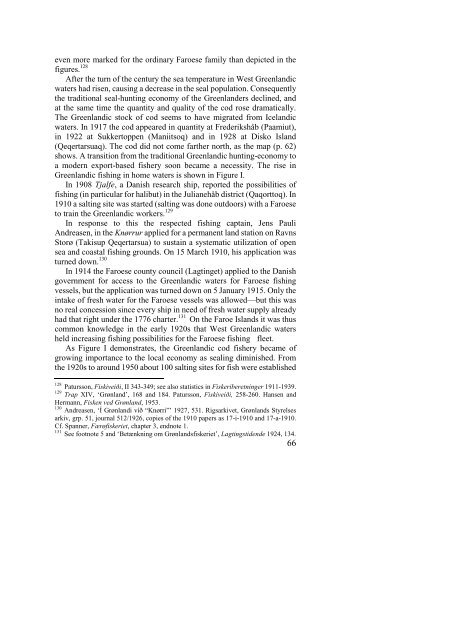The North Atlantic Fisheries, 1100-1976 - University of Hull
The North Atlantic Fisheries, 1100-1976 - University of Hull
The North Atlantic Fisheries, 1100-1976 - University of Hull
You also want an ePaper? Increase the reach of your titles
YUMPU automatically turns print PDFs into web optimized ePapers that Google loves.
even more marked for the ordinary Faroese family than depicted in the<br />
figures. 128<br />
After the turn <strong>of</strong> the century the sea temperature in West Greenlandic<br />
waters had risen, causing a decrease in the seal population. Consequently<br />
the traditional seal-hunting economy <strong>of</strong> the Greenlanders declined, and<br />
at the same time the quantity and quality <strong>of</strong> the cod rose dramatically.<br />
<strong>The</strong> Greenlandic stock <strong>of</strong> cod seems to have migrated from Icelandic<br />
waters. In 1917 the cod appeared in quantity at Frederikshåb (Paamiut),<br />
in 1922 at Sukkertoppen (Maniitsoq) and in 1928 at Disko Island<br />
(Qeqertarsuaq). <strong>The</strong> cod did not come farther north, as the map (p. 62)<br />
shows. A transition from the traditional Greenlandic hunting-economy to<br />
a modern export-based fishery soon became a necessity. <strong>The</strong> rise in<br />
Greenlandic fishing in home waters is shown in Figure I.<br />
In 1908 Tjalfe, a Danish research ship, reported the possibilities <strong>of</strong><br />
fishing (in particular for halibut) in the Julianehåb district (Qaqorttoq). In<br />
1910 a salting site was started (salting was done outdoors) with a Faroese<br />
to train the Greenlandic workers. 129<br />
In response to this the respected fishing captain, Jens Pauli<br />
Andreasen, in the Knørrur applied for a permanent land station on Ravns<br />
Storø (Takisup Qeqertarsua) to sustain a systematic utilization <strong>of</strong> open<br />
sea and coastal fishing grounds. On 15 March 1910, his application was<br />
turned down. 130<br />
In 1914 the Faroese county council (Lagtinget) applied to the Danish<br />
government for access to the Greenlandic waters for Faroese fishing<br />
vessels, but the application was turned down on 5 January 1915. Only the<br />
intake <strong>of</strong> fresh water for the Faroese vessels was allowed—but this was<br />
no real concession since every ship in need <strong>of</strong> fresh water supply already<br />
had that right under the 1776 charter. 131 On the Faroe Islands it was thus<br />
common knowledge in the early 1920s that West Greenlandic waters<br />
held increasing fishing possibilities for the Faroese fishing fleet.<br />
As Figure I demonstrates, the Greenlandic cod fishery became <strong>of</strong><br />
growing importance to the local economy as sealing diminished. From<br />
the 1920s to around 1950 about 100 salting sites for fish were established<br />
128 Patursson, Fiskiveiði, II 343-349; see also statistics in Fiskeriberetninger 1911-1939.<br />
129 Trap XIV, ‘Grønland’, 168 and 184. Patursson, Fiskiveiði, 258-260. Hansen and<br />
Hermann, Fisken ved Grønland, 1953.<br />
130 Andreasen, ‘Í Grønlandi víð “Knørri”’ 1927, 531. Rigsarkivet, Grønlands Styrelses<br />
arkiv, grp. 51, journal 512/1926, copies <strong>of</strong> the 1910 papers as 17-i-1910 and 17-a-1910.<br />
Cf. Spanner, Færøfiskeriet, chapter 3, endnote 1.<br />
131 See footnote 5 and ‘Betænkning om Grønlandsfiskeriet’, Lagtingstidende 1924, 134.<br />
66















